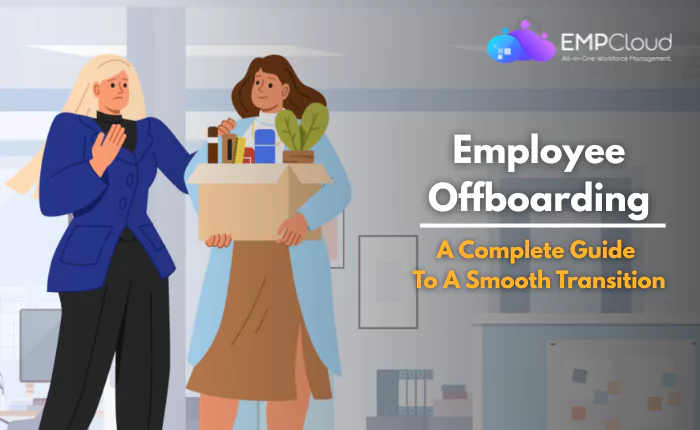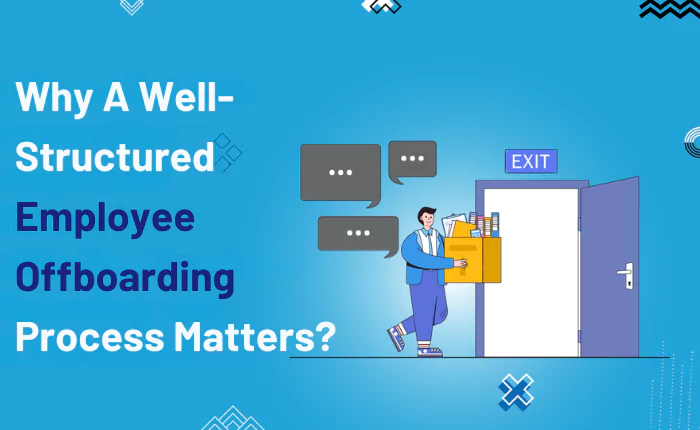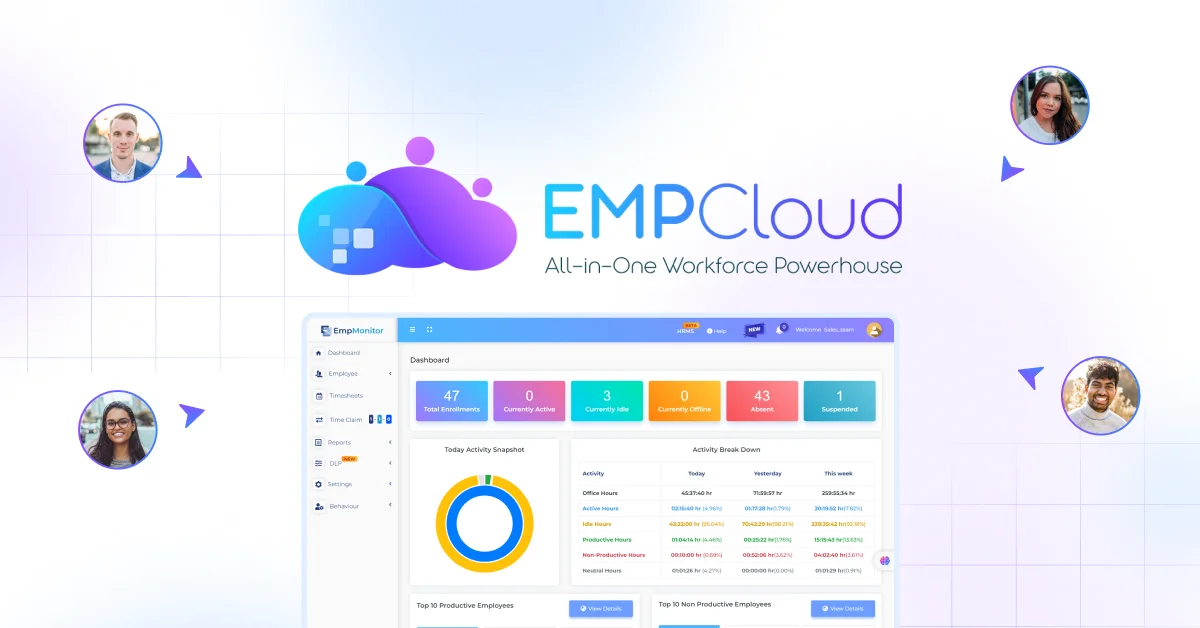
Employee offboarding is a crucial yet often overlooked process in workforce management. A structured employee offboarding process ensures a smooth transition for the departing employee and the organization. Without a proper plan, companies risk operational disruptions, security breaches, and damaged employer branding.
Unlike onboarding, which focuses on welcoming and integrating employees, offboarding is about maintaining professionalism, securing sensitive information, and leaving the door open for future collaborations. A well-organized process benefits both parties, ensuring compliance with legal requirements while fostering goodwill.
Businesses must follow a clear framework to navigate this process effectively. The next section explores why offboarding matters and how it impacts various aspects of an organization.
In a hurry? Listen to the blog instead!
Why A Well-Structured Employee Offboarding Process Matters?
 A smooth employee offboarding process is more than just collecting ID cards and disabling emails. It directly affects workplace morale, security, and compliance. Poorly managed exits can lead to data leaks, unfinished work, and a negative employer reputation.
A smooth employee offboarding process is more than just collecting ID cards and disabling emails. It directly affects workplace morale, security, and compliance. Poorly managed exits can lead to data leaks, unfinished work, and a negative employer reputation.
When an employee leaves, they take valuable knowledge that, if not transferred properly, can disrupt team productivity. Additionally, unresolved HR and payroll issues may create legal complications. A structured approach ensures compliance with labor laws and maintains positive relationships with former employees.
A well-executed offboarding process also benefits companies by preserving long-term relationships with former employees. Alumni can become brand advocates, referral sources, or even rehires. By ensuring a respectful and professional transition, businesses keep the door open for future opportunities.
With so many moving parts, it’s easy to miss critical steps. It is where an offboarding checklist becomes essential. The next section outlines the key components the company should include in its offboarding plan.
Essential Steps In The Offboarding Checklist
 A well-structured employee offboarding checklist helps organizations maintain consistency, ensure compliance, and provide a smooth transition for both the departing employee and the company. Here are the key steps every business should follow:
A well-structured employee offboarding checklist helps organizations maintain consistency, ensure compliance, and provide a smooth transition for both the departing employee and the company. Here are the key steps every business should follow:
Formal Resignation And Documentation
- Officially acknowledge the employee’s resignation and update internal records.
- Notify relevant teams, clients, and stakeholders about the departure.
- Discuss the final working days, transition expectations, and outstanding responsibilities.
- Ensure contractual obligations, including non-disclosure agreements, are reviewed and finalized.
- Prepare necessary paperwork, including resignation letters and exit forms.
- Provide a clear timeline for the offboarding process to set expectations for all involved.
Knowledge Transfer And Work Handover
- Schedule meetings or training sessions for the successor or team members taking over responsibilities.
- Document ongoing projects, client communications, and key operational processes.
- Provide detailed handover notes and ensure a structured transfer of tasks.
- Reassign duties to ensure seamless workflow continuity and avoid disruptions.
- Encourage the departing employee to mentor or assist their replacement if possible.
- Store critical business knowledge in a centralized database for future reference.
IT And Security Protocols
- Revoke access to company systems, emails, and confidential databases immediately.
- Retrieve company-issued devices such as laptops, mobile phones, access badges, and proprietary materials.
- Reset credentials and deactivate software accounts to prevent unauthorized access.
- Conduct a security audit to identify potential risks related to sensitive company information.
- Ensure all intellectual property and data remain with the company.
- Implement data protection policies to prevent breaches after departure.
Payroll And Benefits Settlement
- Process the final salary, bonuses, unused leave payouts, and pending reimbursements.
- Clarify benefits termination or continuation, including health insurance or retirement plans.
- Issue tax documents, severance agreements (if applicable), and other necessary paperwork.
- Ensure all financial obligations between the company and the employee are settled promptly.
- Provide clear communication regarding any post-employment benefits or legal requirements.
- Offer guidance on pension plans, stock options, or deferred compensation benefits.
Conduct An Exit Interview
- Gather honest feedback on the employee’s experience within the company.
- Identify areas for improvement in workplace culture, leadership, and operations.
- Address any concerns or grievances professionally to maintain a positive relationship.
- Document insights from exit interviews to enhance future offboarding processes.
- Offer career transition support, if applicable, to maintain goodwill with departing employees.
- Use feedback to improve employee retention strategies and enhance workplace policies.
While having a checklist ensures no critical steps are missed, executing these tasks manually can be time-consuming and prone to human error. The next section explores how automation and workforce management software can simplify offboarding for HR teams, making the process more efficient and seamless.
How Does Employee Management Software Help In Employee Offboarding?
 Handling multiple offboarding tasks manually can be overwhelming for HR teams. From revoking system access to processing final payments, each step requires precision to avoid errors, delays, and security risks. It is where employee management software becomes an invaluable tool. By automating workflows, HR departments can streamline processes, reduce manual workload, and ensure consistency in every offboarding case.
Handling multiple offboarding tasks manually can be overwhelming for HR teams. From revoking system access to processing final payments, each step requires precision to avoid errors, delays, and security risks. It is where employee management software becomes an invaluable tool. By automating workflows, HR departments can streamline processes, reduce manual workload, and ensure consistency in every offboarding case.
A well-integrated workforce management software also strengthens security protocols. One of the most common risks in offboarding is failing to revoke system access promptly, which can lead to unauthorized access and potential data breaches. Automated solutions ensure that credentials, email accounts, and system permissions are revoked in real-time, eliminating security vulnerabilities.
Beyond security, automation enhances compliance. Employment regulations require companies to handle terminations, final pay settlements, and benefits discontinuation within specific timelines. A digital solution ensures that these deadlines are met, preventing legal complications. Additionally, automated payroll processing minimizes human errors, ensuring accurate and timely settlements, including outstanding reimbursements and severance pay.
With the right tools, businesses can transform offboarding into a seamless, structured process that benefits the organization and departing employees. One platform that simplifies employee offboarding is EmpCloud, designed to efficiently manage the process while ensuring compliance, security, and a positive offboarding experience.
How EmpCloud Can Simplify Employee Offboarding?
 EmpCloud will be a comprehensive employee management software suite designed to streamline and automate the employee offboarding process. By integrating automation and compliance-driven workflows, EmpCloud will help businesses reduce administrative burdens, maintain security, and ensure a seamless transition for departing employees.
EmpCloud will be a comprehensive employee management software suite designed to streamline and automate the employee offboarding process. By integrating automation and compliance-driven workflows, EmpCloud will help businesses reduce administrative burdens, maintain security, and ensure a seamless transition for departing employees.
Key Features of EmpCloud:
- Automated Employee Offboarding Checklist: Will ensure every step of the offboarding process is completed on time, minimizing errors and omissions.
- Access Revocation Management: Will instantly remove employee access to company systems, preventing unauthorized data access and security risks.
- Compliance and Documentation: Will keep all records organized and legally compliant, helping businesses meet regulatory requirements effortlessly.
- Exit Interview Integration: Will allow HR teams to collect structured feedback, providing insights into employee experiences and areas for improvement.
- Payroll and Benefits Finalization: Will streamline final settlements, ensuring accurate and timely processing of payments, benefits, and tax documents.
With EmpCloud, companies will enhance efficiency, improve security, and foster positive relationships with former employees. By simplifying employee offboarding, organizations will be able to focus more on long-term workforce management strategies.
Read More
Master Workforce Management In 2025 Like Never Before!
Five Best Practices For A Smooth Offboarding Experience
 A structured and well-executed employee offboarding process benefits both the departing employee and the organization. It helps maintain company security, fosters positive relationships, and ensures a seamless transition. Here are the best practices businesses should follow:
A structured and well-executed employee offboarding process benefits both the departing employee and the organization. It helps maintain company security, fosters positive relationships, and ensures a seamless transition. Here are the best practices businesses should follow:
Maintain Clear Communication
Open and honest communication is crucial in employee offboarding. From the moment an employee resigns or is informed about their departure, they should be provided with a clear overview of the offboarding checklist and what to expect.
- Outline the timeline, including the last working day, return of company assets, and final settlements.
- Keep them informed about benefits, pending reimbursements, and required paperwork.
- Encourage transparency in discussing concerns or outstanding matters to ensure a smooth transition.
Protect Company Data
Data security is a critical part of offboarding. Departing employees still have access to company files, emails, and sensitive information. Businesses should implement strict measures to safeguard their data.
- Revoke access to all company systems, databases, and communication platforms immediately after the departure date is confirmed.
- Monitor and track any data transfers to prevent unauthorized sharing of confidential information.
- Retrieve company-issued devices such as laptops, mobile phones, and security badges to protect intellectual property.
Support The Departing Employee
Employees leaving on a positive note are more likely to recommend the company, return in the future, or maintain a strong professional relationship. Organizations should offer support and assistance to departing employees where possible.
- Provide career transition resources, such as job referrals, resume assistance, or networking opportunities.
- Offer a comprehensive exit interview to gather feedback about their experience and identify areas for improvement.
- Keep doors open for potential rehiring by maintaining a respectful and supportive offboarding process.
Streamline The Process with Technology
Manual offboarding can be time-consuming and prone to errors. Businesses should leverage workforce management software to ensure efficiency and compliance.
- Automate repetitive tasks such as exit surveys, access revocation, and documentation updates.
- Track offboarding progress in real-time to ensure all required steps are completed.
- Standardize the process to maintain consistency across all departments and minimize legal risks.
Maintain A Positive Offboarding Culture
A strong offboarding culture contributes to the company’s reputation and long-term success.
- Treat departing employees with respect and appreciation, regardless of the circumstances of their exit.
- Conduct exit interviews professionally, focusing on constructive feedback and mutual understanding.
- Keep alumni networks active by staying connected with former employees through newsletters or professional groups.
By following these best practices, companies can transform offboarding into a structured, professional, and employee-friendly experience.
Long-Term Benefits Of A Strong Offboarding Strategy
 A well-structured offboarding process does more than just ensure a smooth transition—it has long-term advantages for employees and the organization. Companies that prioritize effective offboarding can strengthen their brand reputation, enhance security, and create a valuable talent network.
A well-structured offboarding process does more than just ensure a smooth transition—it has long-term advantages for employees and the organization. Companies that prioritize effective offboarding can strengthen their brand reputation, enhance security, and create a valuable talent network.
Strengthening Employer Branding
Employees who leave on good terms are to speak positively about the company, which can boost employer branding. When former employees share their positive experiences, it helps attract top talent and build trust with future candidates.
Enhancing Data Security and Compliance
A structured offboarding process minimizes the risks associated with data breaches and compliance violations. By implementing employee management software, businesses can ensure that all security measures are followed, protecting sensitive company information.
Building A Strong Alumni Network
Staying connected with former employees through alumni programs or professional networks can be beneficial in the long run. Rehiring former employees who already understand company culture and operations can save recruitment costs and training time.
Gaining Valuable Insights
Exit interviews provide a unique opportunity to gather honest feedback. Understanding why employees leave and identifying trends can help businesses improve workplace policies and retention strategies.
By investing in a structured employee offboarding process, companies can turn departures into opportunities, creating a stronger, more resilient workforce.
Conclusion
A well-structured employee offboarding process is essential for ensuring a smooth transition, protecting company assets, and maintaining positive relationships with departing employees. By implementing a clear checklist, businesses can standardize their approach, minimize risks, and create a professional offboarding experience.
Leveraging workforce management software like EmpCloud can enhance efficiency by automating repetitive tasks, ensuring compliance, and maintaining security. When handled correctly, employee offboarding not only protects an organization’s interests but also leaves a lasting positive impression on former employees, strengthening employer branding and opening doors for future collaboration.
By prioritizing a structured and strategic offboarding process, businesses can foster long-term success, enhance workplace culture, and ensure operational continuity.
FAQs On Employee Offboarding
1. Why is offboarding important for businesses?
Offboarding is crucial for maintaining company security, ensuring a smooth knowledge transfer, and protecting business continuity. A structured process also helps preserve professional relationships and strengthens employer branding.
2. How can poor employee offboarding impact a company?
Ineffective offboarding can lead to security risks, data breaches, compliance issues, and workplace disruptions. It can also harm an organization’s reputation, making it harder to attract and retain talent.
3. What legal considerations should businesses keep in mind during offboarding?
Companies must ensure compliance with labor laws, contract terms, and data protection regulations. This includes finalizing non-disclosure agreements, issuing tax documents, and securely handling employee records throughout the process.
4. How can companies maintain a positive relationship with departing employees?
Providing a structured exit experience, offering career transition support, and conducting professional exit interviews can help businesses maintain positive relationships with former employees, increasing the likelihood of rehiring or referrals.
5. How long should the employee offboarding process take?
The duration of employee offboarding depends on company policies and the complexity of the employee’s role.


